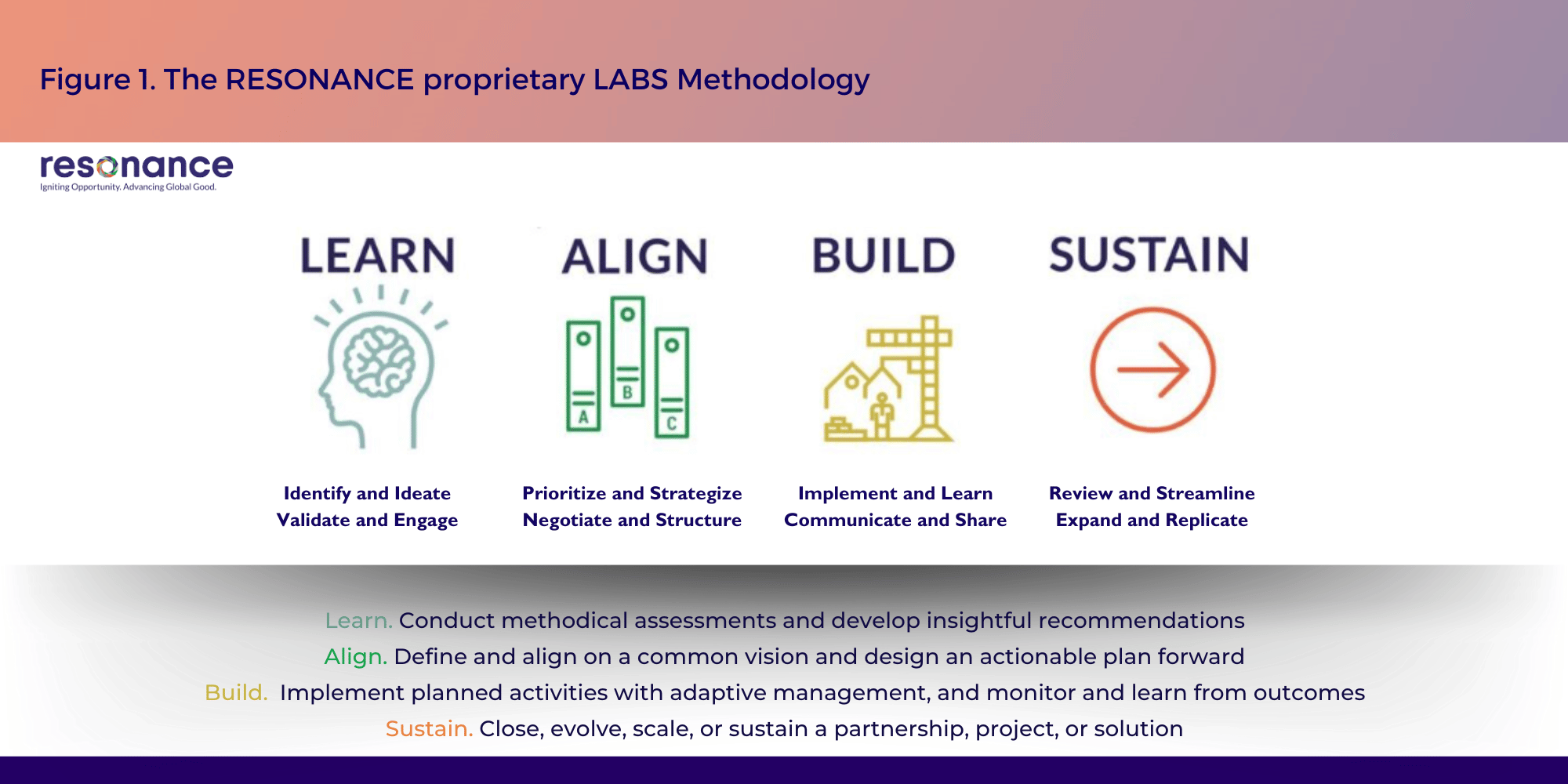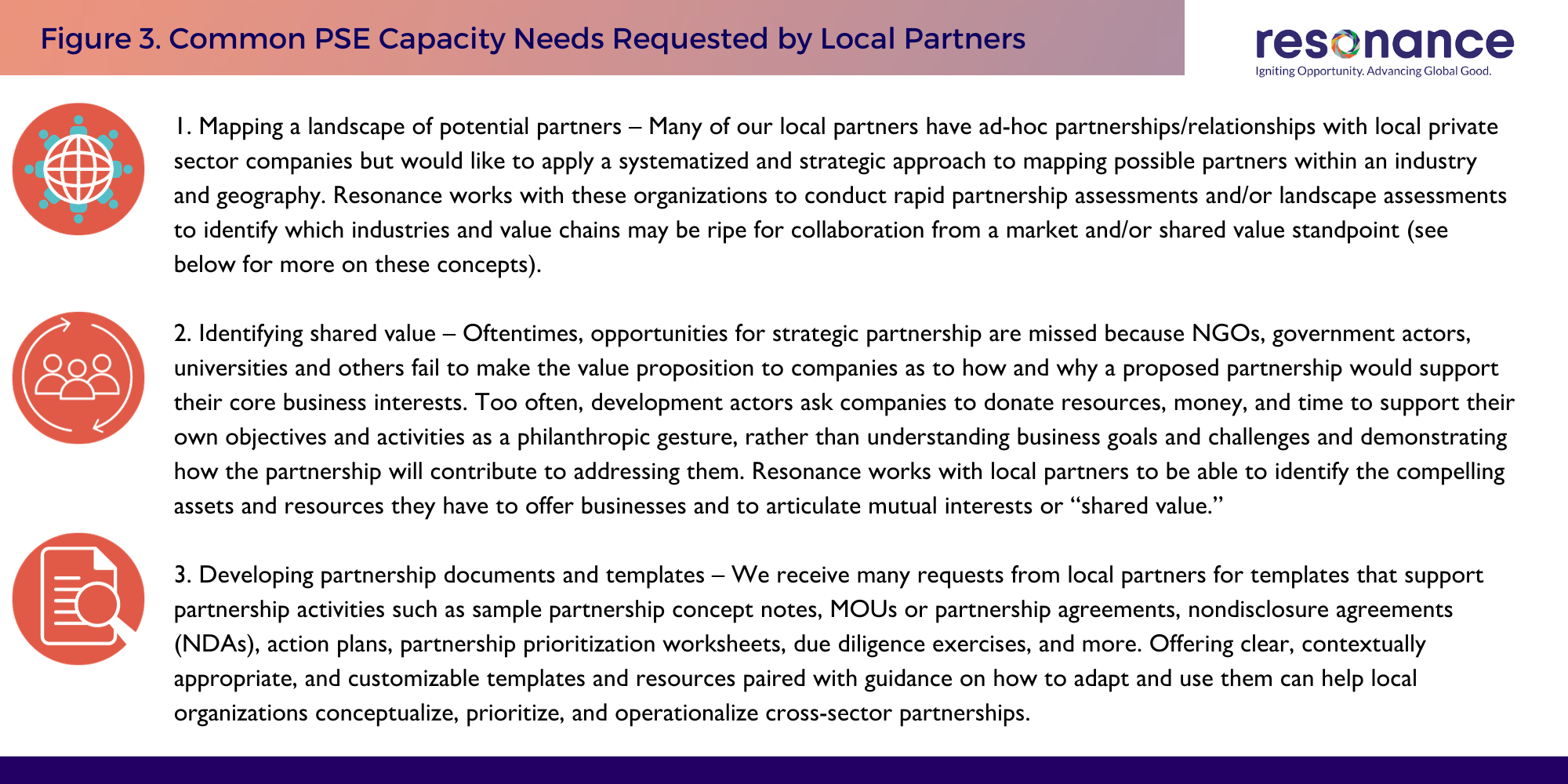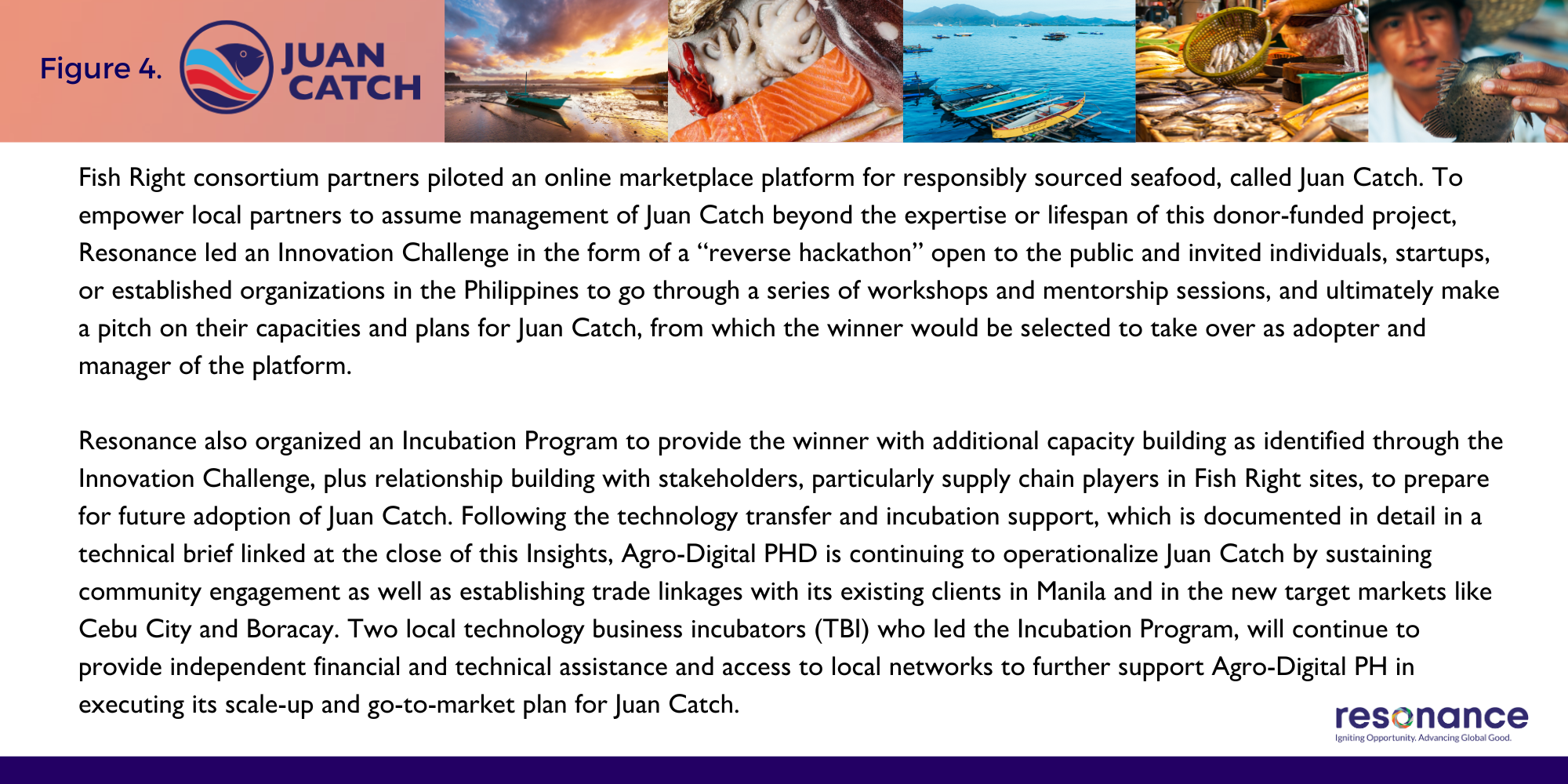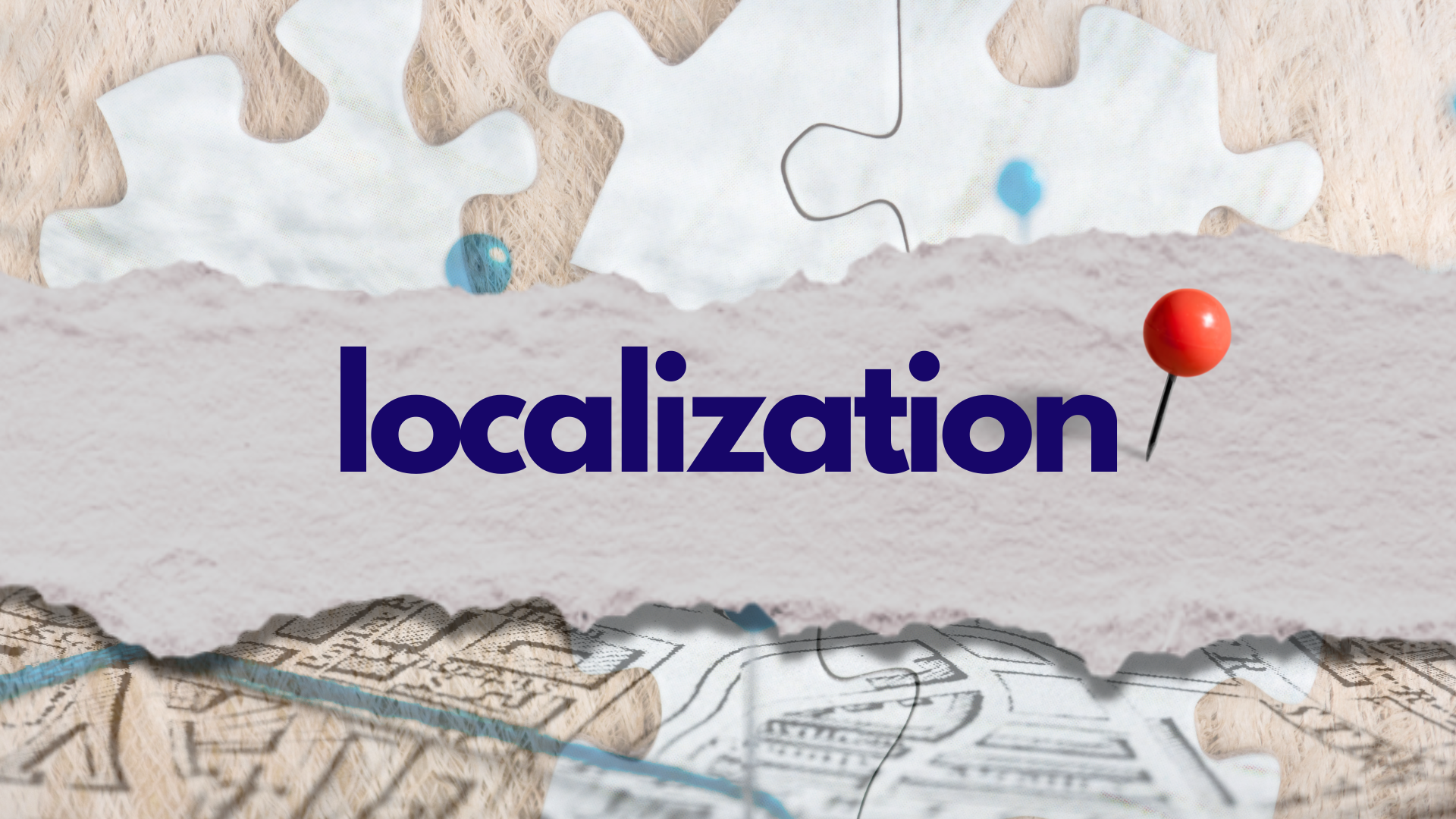Locally led cross-sector partnerships are critical for sustainable, impactful, and scalable solutions to complex development challenges such as global poverty, food insecurity, climate change, human trafficking, gender inequity, and others. Although the importance of private sector engagement (PSE) and the opportunities it presents has been embraced by the international development community for years, implementers of donor-funded projects must not overlook the role of local institutions when it comes to cross-sector collaboration for development and sustainability.
Local NGOs, community organizations, governments, social enterprises, universities, and others are best placed to identify community needs, design contextually relevant and feasible solutions, and manage relationships for sustainable results that outlive the typical three- to seven-year donor-funded project lifecycle.
Resonance has been driving PSE processes and implementing cross-sector partnerships since its founding in 2005. During that time, we’ve worked with thousands of local experts and partners, and we’ve seen varying degrees of success in donor-funded projects’ efforts to cultivate and sustain locally led partnerships. Throughout our journey and via dedication to sound monitoring, evaluation, and learning (MEL) we’ve documented key learnings, promising practices, and tips for successful locally led cross-sector collaboration.
Five Key Takeaways on the Role of Locally Led PSE in Driving Impactful Solutions
What we have learned in our nearly two decades in partnership work is that catalyzing and facilitating local involvement and leadership in solutions and initiatives is not formulaic. In other words, locally led development is not a single approach, but rather a range of ways that donor agencies and organizations like USAID, partners, and communities can work together to shift agenda-setting and decision-making power into the hands of local actors and stakeholders.
Over the duration of our activities and expansive portfolio, we have identified five key takeaways on the role of locally led PSE in driving more meaningful and impactful solutions, further illustrated by examples from two of our recent initiatives:
1. Hire a strong local Partnership Specialist (or Cultivate One!).
Step one in driving locally led PSE is to engage a dynamic Partnership Specialist if available who brings to the table local networks, contextual knowledge, and experience building cross-sector partnerships to spearhead efforts on the ground on a day-to-day basis.
In those countries where cross-sector partnerships are a more nascent concept and thus a partnership specialist is not overtly identifiable, implementing organizations should consider cultivating someone with networking capacity as well as depth across an array of partnership soft skills at the local level to fill this important role.
With some guidance, training, and exposure to the LABS methodology (see Figure 1 below), a local person with experience and abilities in relationship-building, problem-solving, negotiation, and broad familiarity with the private sector or market-driven solutions, can be a critical facilitator in the success of partnership undertakings.
Resonance leans heavily on the local Partnership Specialists that we hire to advise on which private sector companies, organizations, and stakeholders we should be talking to, open doors for initial meetings, ensure that PSE activities and support provided to local partner organizations is culturally and contextually relevant and appropriate, and serve as our eyes and ears on the ground
An effective Partnership Specialist is one that is well equipped to advise on key market dynamics and constraints, identify PSE capacity support needs among local partners and provide mentorship and training to build necessary skills, make introductions between project grantees or partners and private sector companies, help “translate” between the two to identify mutual interests and opportunities for collaboration, and drive sustainability by handing off partnership management to capable local partners.
Learn 5 Interview Questions to Ask When Hiring a Partnership Specialist
2. Engage a network of local partners from the get-go through a “coalition-led” approach to PSE.
To ensure partnerships are sustainable and impactful in the long run, partnership activities should be housed within local institutions like universities, government initiatives, and NGOs. These actors should be engaged as active participants in the partnership/activity design process early on. A transition plan should be built right into the initial partnership design with a focus on capacitating local partners to assume ownership and management of partnerships over time without the need for external support.
For example, as a sub-implementer tasked with building cross-sector partnerships to combat illegal fishing and advance sustainable fisheries management on the USAID Fish Right project in the Philippines, Resonance built up a consortium of local partners to implement 12 strategic partnerships. The multiple workstreams were led through various local NGOs, universities, government platforms, innovation and business incubators, and other organizations.
In many cases, Resonance’s role centered on facilitating introductions between public and private sector organizations that had not worked closely together previously. Not only did these organizations discover they could reduce gaps in resources or capacities by collaborating, but also a few financing providers were able to identify value and mitigate risks in expanding their clientele to include small-scale fishers’ groups or entrepreneurs.
As the partners’ mutual understanding of objectives and drivers deepened, Resonance supported the co-design process towards a joint workplan and resource sharing plan, with the ultimate goal of formalizing each partnership through a memorandum of understanding (MOU). The Fish Right consortium partner that was in the position to sustain and scale-up the partnership post-Program generally became the MOU signatory on behalf of the consortium.
Figure 2 below highlights one such partnership driven by local actors through Fish Right..png?width=2000&height=667&name=Fig%201%20Fish%20N%20LEarn%20(1).png)
3. Bake PSE capacity development for local partners into your core project activities.
While some local partners may have experience strategically collaborating with the private sector to drive development outcomes, this is an entirely new concept for many NGOs, government actors, and other local entities, and can be quite daunting for those new to PSE. They may be skilled at key ingredients of PSE such as project management and relationship building, yet aren’t sure where to start when it comes to identifying and engaging relevant private sector partners. Many feel like they are asking for “hand-outs” from companies rather than presenting themselves as compelling and strategic partners.
It’s important to include components of training and mentorship support for local partners who are new to PSE in the project approach and work plan to establish a strong foundation for locally led partnerships.
For example, through our work on the USAID funded Youth Advance project, which focuses on improving livelihoods for vulnerable youth in Liberia, Resonance is leading an ongoing series of PSE trainings and mentorship support for Youth Serving Local Organizations (YSLOs) consisting of NGOs who support youth empowerment and employment in project counties.
Throughout our three years on the project, our approach intentionally shifted from Resonance-led to locally led partnership development and management by equipping YSLOs with the skills to identify, approach, and engage local companies, design partnership concepts, execute MOUs and manage partnership activities on an ongoing basis. At the time this was written, Resonance helped formalize ten MOUs between local Youth Advance partners and private sector companies, with more in the works, and continues to provide strategic guidance and PSE training for YSLOs.
Figure 3 below highlights the most commonly requested support needs from the dozens of YSLO representatives that Resonance has trained through Youth Advance and other projects to date. 
4. Map the value chain to support local relevance and sustainability.
A common mistake when working with local organizations on PSE is to approach partnerships in a vacuum or as one-off initiatives (e.g., partner with any company who will talk to you!).
For ultimate sustainability and impact, it’s important that partnerships are market relevant and strategically grounded in local contexts. Working within the local innovation ecosystem to conduct an economic analysis and deferring to their understanding of the local context to best capitalize on industry trends is key to success.
For example, through the USAID Youth Advance project in Liberia, Resonance relied heavily on our local Private Sector Partnership Specialist and market data to advise on those industries ripe for workforce development and job opportunities. Rather than cast a wide net and approach considering any and every private sector company, we identified various industries such as hospitality and clean energy that demonstrate potential for growth and job creation in Liberia, especially during the ongoing economic slump that the country is facing.
Similarly, in the Philippines, Resonance and its local partners seized on growing interest in online B2B platforms, spurred by COVID-19 related supply chain challenges, to pilot an online marketplace for responsibly sourced domestic seafood, as illustrated in Figure 4, below.

5. Prioritize communication, delegation, and adaptive management as core to localization approaches.
As described, local expertise and intentional off-ramp planning are essential to locally led PSE. Up front, extensive communication is important to ensure that Resonance understands the local context, dynamics, players, and opportunities to provide tailored guidance and tools; that the local Partnership Specialist and/or local consortium partners understand the project objectives and customize the methodology for delivering cross-sector partnerships in the unique context; and that we inform and maintain alignment with the client.
Over the course of implementation, strong skills and processes for adaptive management are needed to mitigate challenges and seize emerging opportunities. Despite the impacts of COVID-19 in the Philippines, our local Fish Right partnerships team was able to maintain relationships with current and potential partners, provide ongoing site-level monitoring and coordination, pivot in response to challenges, and deliver the capacity building and smooth handovers needed for post-project sustainability.
USAID’s Shifting Priorities to Locally Led PSE and Development Echo Lessons Learned
Collective attention to current and emerging complex and even wicked social, environmental, and development problems, articulated in several recent global signatory commitments, is the recognition that individual governments, organizations, and stakeholders cannot tackle these challenges alone. Leaders at all levels have stated the kind of urgent, transformative, breakpoint change necessary for problem solving will require intentional and meaningful cross-sector partnerships. And that includes an emphasis on access, standing, and influence of local organizations and stakeholders across the entirety of an initiative and activities.
In support of this aim, USAID as one of many catalyst and donor organizations in global development has established a vision reinforcing the important role of locally led PSE and development. In a departure from years of simply channeling assistance to local organizations, “localization” as articulated in the USAID Local Capacity Development Policy seeks to move the agency’s support beyond just building the capacity of local organizations with a target of 50% of programming placing “local communities in the lead to either co-design a project, set priorities, drive implementation or evaluate the impact of our programs” by the end of the decade.
This new policy approach makes the starting point an understanding of the local system, how local organizations fit into the local system, and the priorities, strengths, and goals of local actor, focusing on strengthening their existing capabilities and identifying drivers and barriers. Regarding the latter, there are many given the complexity of challenges across all partners, including donor and catalyst organizations associated with pivoting, internal capacity-building, and resourcing.
This path forward also presents an array of opportunities and will require sometimes difficult decisions and innovative actions in overcoming and managing these obstacles. These five key insights from our extensive experience at Resonance, alongside no doubt other advisement and best practices, have transferable learning. We look forward to documenting and sharing new takeaways related to partnership localization as part of this broader catalytic aim.



